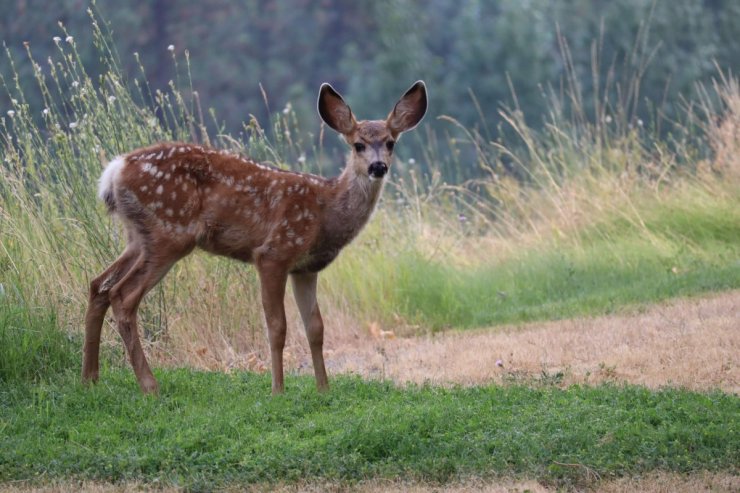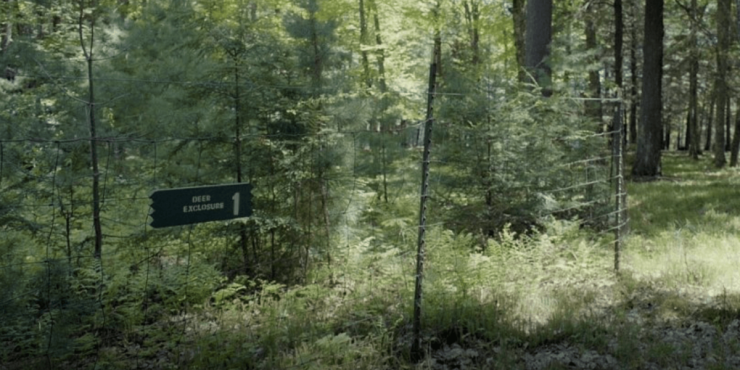
I love deer. They’re beautiful, graceful, serene animals. I also hate deer. They eat the apples from my tree, munch on my kale, and eat my strawberries. How do I reconcile these feelings? Invisible deer fence, of course!
If you’re new to the idea of an invisible deer fence, it’s not the work of wizards and witches. It’s not magic at all, though it can certainly work magic. And though they are “almost” invisible, there is no such thing as truly invisible. These fences do, however, blend in quite well, and may be barely visible from as little as a few feet away.
Discover 7 top tips for growing, harvesting, and enjoying tomatoes from your home garden—when you access the FREE guide The Best Way to Grow Tomatoes, right now!

Making your invisible deer fence and keeping your garden safe
Before you run and get supplies, there are a few things to consider. A hungry deer will go to great lengths to munch on your garden. I know there are some people who have luck with using clear fishing wire as an invisible deer fence. The idea is that the deer won’t see the wire and will get scared off when they walk into it. And aesthetically, it’s about as close to invisible as you can get.
I’m not saying that won’t work. Again, it seems that some folks have found it to be effective. And you can get 100 yards for under $10. It might even be worth trying before you sink money into a larger fencing system. All you need is your fishing line and some garden stakes.
Then simply secure your stakes around the perimeter at 6-foot intervals. Attach your fishing line, tying it at each post all the way around the perimeter. Add five or six rows at even intervals to create your fence.
For the gate, simply plant two stakes about an inch apart. End your rows of fishing lines on one stake and restart them on the next. Then you pull a stake up and move the fence out of the way whenever you want to enter your garden.
If there’s yumminess somewhere else nearby, this might be enough to keep deer out of your garden. But deer are persistent when it comes to food. If this doesn’t work, or if you want to skip the attempt and go for a more exclusionary invisible deer fence, you’ll need to get a little more serious about the construction.
First, determine the perimeter of your garden. Measure each side and add them together. A rectangular garden with sides measuring 15 feet on each end and 20 feet in length would have a perimeter of 70 feet. So you’ll need a roll of fencing that’s at least 80 feet long. It’s always good to have a little extra for mistakes.
Now to determine how many posts you’ll need, divide your perimeter by six, since you’ll want a post every 6 feet. For our example above, you’d need 11.66 posts, which, of course, is just silly. So, rounding up, we have 12 posts.
If you want to get really serious, you can use lumber for your posts and secure them with concrete. That’s a little more than I want to get into, personally, and it kind of counters the idea of an invisible deer fence.

Invisible deer fence surrounding deer exclosure.
Image courtesy of Michigan Technological University.
I imagine for most of us, steel 10-foot T-Posts are sufficient. They’re designed to self-anchor, it’s easy to attach fencing to them, and the dark green blends into the environment well. And the 10-foot posts will leave you with 8 feet above ground.
Important! Before you dig, know what’s below! Call 811 to ensure there are no utility lines buried in the place you plan to erect a fence. Pounding T-Posts into the ground isn’t such a rewarding experience if you hit a gas line.
Now, assuming everything is clear, place your posts around the perimeter of your garden at 6-foot intervals. Use a post pounder to help get the posts into the ground. Once that’s complete, it’s time to install the fencing. It’s tough to find a good middle ground between affordable, decent quality, and also relatively invisible. Heavy duty poly plastic fencing has a reinforced bottom, making it more difficult for deer and other critters to get underneath it.
As you unroll your fence, attach it to the T-Posts with wire clips or zip ties. Work your way around the perimeter until you get to the final post. Don’t go all the way around, since you still need a gate!
There are several options for gates. The easiest way is probably to just use T-Post hinges and hang your gate right on that.
Your last step is to sit back with a cold beverage and enjoy your handiwork, although you probably won’t be able to see it very well if you’re more than a few feet away!
Have you successfully built an invisible deer fence? Do you have any other tips for keeping deer out of your garden? Let us know in the comments below.
Note: Food Gardening Network contains links to affiliate websites, including Amazon and Rakuten Affiliate Network, and we may receive a commission for any eligible purchases made by you through links on this page. Any reviews are based on honest reviews of the products.
Discover 7 top tips for growing, harvesting, and enjoying tomatoes from your home garden—when you access the FREE guide The Best Way to Grow Tomatoes, right now!





Don’t have a deer problem, but we sure have a Kangaroo and rabbit problem. Nothing seems to work with the Roos. A burried netting fence ( netting in the ground and flat out from the fence) , of course you still need the above ground netting as well, It seems to deter the rabbits for some time. Even electric fences don’t seem to deter kangaroos.
Even tree guards don’t stop them, if the tops of the guards have netting it slows them down, till they manage to up end the whole thing.
Would love some thoughts ………
And out from the fence
We have had a deer fence up for 9 years but it has deteriorated. Plan to put a new one up this spring.
It worked very well to keep critters out until a bear ran through it one year. Repaired it.
We buried the bottom few inches to keep squirrels, rabits etc out but did have a ground hog burrow deep under. Shot it.
I have tried sprays, soaps, hair, animal urine, water and light timers but after awhile nothing seems to work but a 7″ high fence. Nancy
I used dog hair put into panty hose , in abou 2″ of srockings , rubberband closed at each end . then hung in stakes around my garden . The dog scent kept the deer clear of that area
We have a fence that keeps the deer out. Our problem is chipmunks. They tunnel in and eat more crop than we do! Any suggestions are welcome!
The suggested fencing might be heavier than what I’ve used around veggie beds but poly one I have isn’t chew resistant by hungry bunnies unfortunately. We ended reinforcing lower section with chicken wire. Squirrels and chipmunks etc can make it through and chew off beets, carrots and sample tomatoes. Haha I haven’t found the impenetrable fortress yet ????????
I dug a 2 ft. trench around outside of my fenceline and placed rolls of fencing in the trench, then covered with dirt to keep out burrowing animals. It worked for me keeping out dogs, squirrels, fox and rabbits. Hope it will work for you.